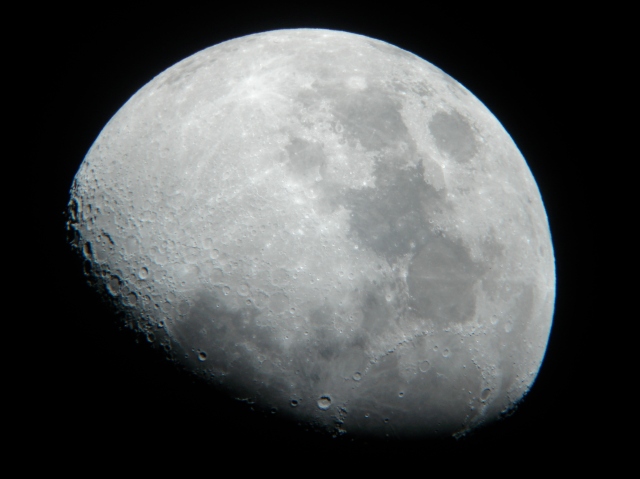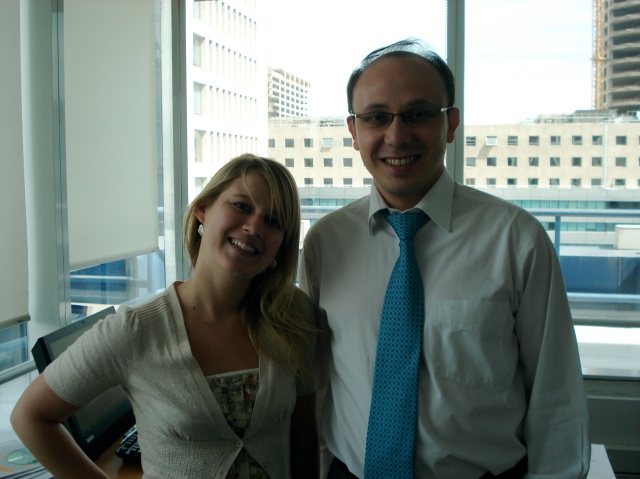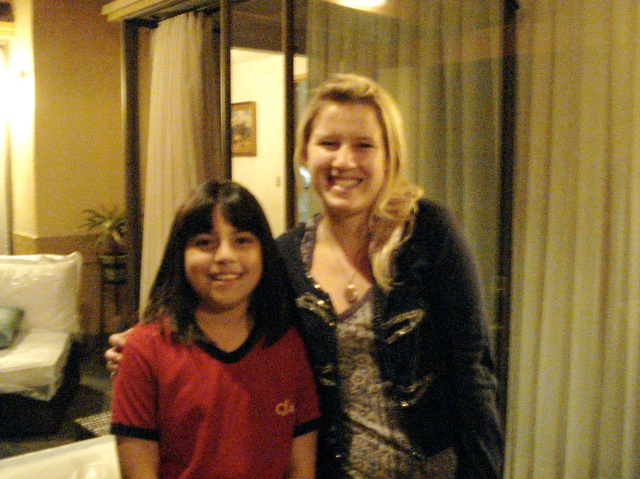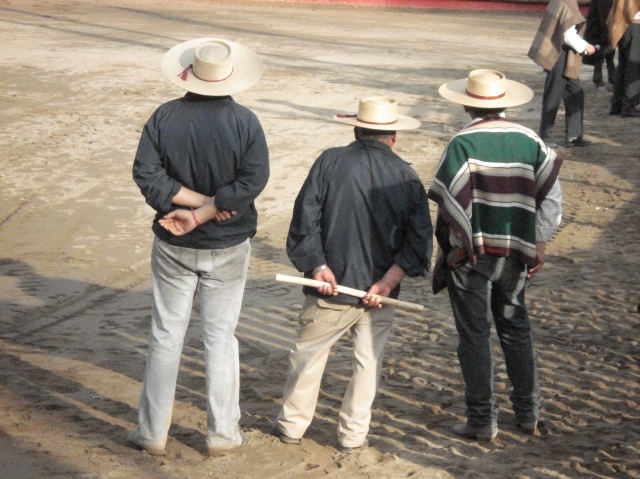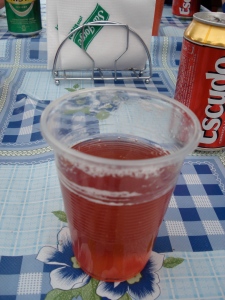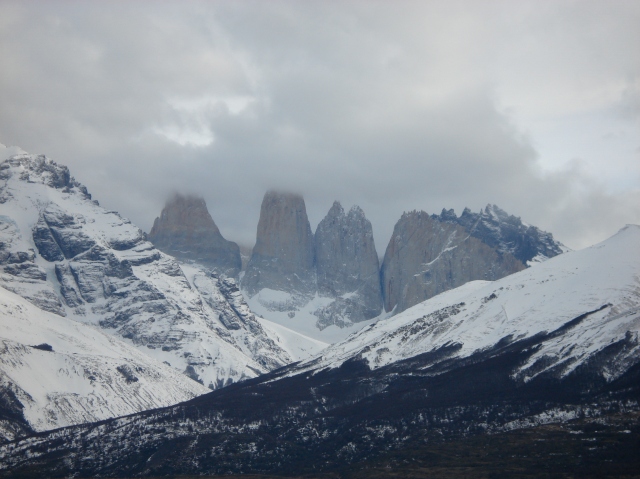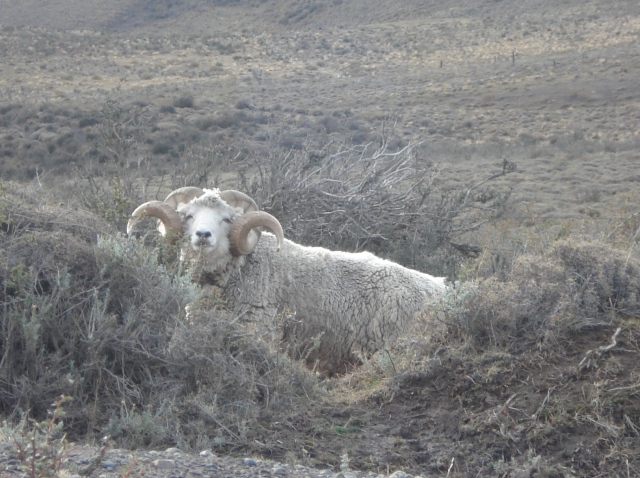We spent an incredible seven days in Iquique, Chile. Perhaps the best of our past ten months to date. We would wake up in our beach house turned into a hostel, slip on a swim suit and walk to the fish market. We ate fresh ceviche every day for breakfast, watched the sealions swim below the fishing dock, and spent the rest of the day on the beach reading, surfing and throwing the frisbee on the beach. We made some incredible friends with promises of free places to stay in the countries they call home- Italy, France, Australia, Brazil, Canada.
We bought bus tickets for 8 am Saturday morning and reluctantly said our goodbyes. As we waited on a bench that morning, I got up to buy a bottle of water for the 4 hour journey to Arica. Two men approached our bench and asked Walt and our Canadian friends if they had dropped a $1 bill. Walt leaned to the left to help translate for our friends, who speak no Spanish. Within those five, maybe 10 seconds a third man came up and took Walt’s backpack. As soon as we noticed, we were devastated. We still are. The backpack contained both of our Apple laptop computers, Walt’s video camera, all chargers for other electronics (though I still have my camera, with half battery power), my towel, Walt’s sunglasses, all of our toiletries, three books and my journal. Both computers were old, but what they had on their harddrives was most important. As a friend said to me earlier this week, it is a writer’s worst nightmare. We are heartbroken, but as much as it discourages us, we are trying not to lose sight of our goal. I want to see Peru and Ecuador, and don’t want those thrives to steal that opportunity as well. I’m including this experience on my blog not for sympathy, but to acknowledge that without my computer and my ability to upload photos, this blog can’t possibly be what I had genuinely hoped for over the next two months. But for my friends, family, and former coworkers who have supported me so much over these past two months, I will do my best to update as much as possible from Internet cafes, as I am doing now. My next priority is finding another journal.
cosas son cosas
día 4-6: san pedro de atacama
“Donde hay agua, hay vida.”
If there is any logic to the natives living in the San Pedro de Atacama desert, it’s just that.
That, or the rumor that the high levels of quartz in the mountains and sand gives people natural positive energy. I’m typically a skeptic towards ideas like that, but how else can you explain the pervasive happiness in such a dry, desolate, scorching by day, freezing by night locale? There are a zillion different tours of the natural attractions near San Pedro, but what interested me more were the people who were born here, the people who live, work and go to school here every day. Although they are Chilean, they look completely different from Santiguinos- their skin is darker, noses flatter, bodies more compact- a true testament to how our bodies can evolve to best suit our environment.
There are signs everywhere reminding you that water is scarce, to please use it sparingly. The water pressure at hostels and restaurants is extremely low. And everyone has rain barrels set atop of their roofs, just in case it happens to rain.
It was especially surreal to visit the cemetery of San Pedro. Just steps from the crowded bus station, this small cemetery was serene and haunting. The only sounds were of sand blowing over the different grave plots and monuments. In America, we obsess over how our loved ones are buried: grass is manicured, flowers are arranged perfectly, stone engravings are mechanically carved and symmetrical. But in San Pedro’s cemetery, resources are scarce. Headstones, like almost all residences and stores, are made from adobe, a sand and mud mixture that hardens when it’s compressed into bricks. Names of the dead are scribbled with permanent marker or carved into old tree branches. Fake flowers or cactuses are displayed in used liter bottles or recycled jars. Nevertheless, the love was there, and the absence palpable.
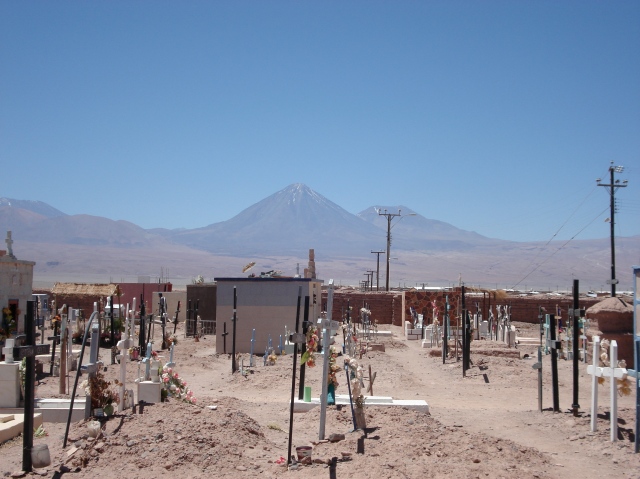
The San Pedro de Atacama cemetery in front of the vulcán, which has been dormant for several years. © Chelsea Cook
San Pedro is beautiful, and extremely different from any environment or landscape I’ve ever seen. But because of this, tourism and tour companies have exploited San Pedro’s natural phenomena beyond belief. It’s simply impossible to spend a day sight seeing or hiking without paying someone to provide you with the service. There are no public buses to the parks, and no parks within walking distance. Therefore, spending time in San Pedro is quite expensive. (Not to mention food, vegetables and drinks are shipped in, increasing these prices as well.) But how could we spend three days and two nights in San Pedro without seeing the famous natural beauty it’s known for? We chose a couple of more cost-effective options, and I think experienced the desert in the best ways possible.
The first night of our arrival, we met a Dutch couple at our hostel who were headed to a stargazing tour on a “telescope farm.” We had read a bit about this tour in our guide book and, having a general interest in stars and the universe, thought it’d be worth the money. The tour was spectacular. A French man, Alain, who moved to San Pedro with his Chilean wife, built a bizarre octagonal house in the middle of the desert and paved parts of his land and set up about 10 telescopes. Three of the telescopes were extremely high-technological machines from Japan and the U.S., but the majority he made himself. After a brief lecture about what we can see in the sky with the naked eye, we set off looking through each telescope- in two we could see the moon quite well and I was even able to take a photo through one! In one, we could see some clustered galaxies and another, Jupiter- stripes and all. Aside from a few cheap jokes about how stargazing was a good way to win a date with a girl, the three-hour session was really interesting. It was especially cool to see all of these star formations from a different hemisphere, and to understand why what we saw that night was different from what we see at home.
The following morning, we set out to find some horses. Walt hadn’t ridden a horse since his trip to the Grand Canyon several years ago, and I hadn’t since Girl Scout camp, so we thought it could be a fun, different way to see the bizarre rock formations of the desert. Most people take buses or bikes, so it truly did feel special to see these incredible landforms on horseback. We left at about 4:30, with the intention of ending our ride with the sunset. After arriving to the ranch and meeting our horses, Walt and I were a bit nervous about how little instruction we received. I had to ask if we use the same “sounds” for stop (“whooooaaa”) and go (“nk nk” or “giddy up”), or if they were different in Spanish. Our guide joked not to worry, the horses spoke English, but indeed, different sounds and words were used.
The first 45 minutes of the ride went smoothly. We had to travel down a gravel road and then into the thicket of cactus-like plants and trees. My horse, named “Pan Dulce” or, “Sweet Bread”, was a little uneasy, but mainly he kept wanting to stop and eat, or jerk the reins from my hands. I remember thinking “Why was I nervous, this is lovely.” About 45 seconds later we arrived to the beautiful sandy landscape surrounded by layercake red and brown rock formations and sand dunes. Suddenly, Pan Dulce was overcome with the need to be free and run wild and began bucking. I had no idea how to handle the situation and tried to stay on his back. Eventually he raised up on two feet, and threw me off to the right. I was terrified he’d come back around and trample me, but luckily he ran off into the desert.
It was really scary. I was unsure if I was hurt or what to do next. Part of me wanted to be a child and refuse to get back on a horse ever again in my life. Part of me wanted to demand a truck to come rescue me. And part of me realized that I wasn’t terribly injured, we were 5 km into the desert and I needed to get back on that horse to get home. Well, not that horse. After our guide eventually caught Pan Dulce, he took him out for a few laps around the dune to wear him out. Walt volunteered to switch horses with me, which was really kind. But even with his horse, I was a bit traumatized and anxious to get back. The old adage goes, “get back on the horse,” and I guess I did. I hope the experience won’t prevent me from getting on a horse in the future because in reality, the incredible views, the gorgeous colors of the changing rocks at sunset and the notion that I rode a horse in the San Pedro de Atacama Desert may all be well worth it.
So, I leave San Pedro with a few cuts and a huge bruise on my hip (but no sunburn!), but also with the silly notion that I made it out of the desert. Whenever Walt and I are having a rough time in our journey here, he often says, “we’ve got to do our time in the desert,” to express there are good things to come. Tonight, we head to Iquique, a lazy surf town in the north of Chile. I can’t wait to sit on a beach and relax.
el primer día: la serena
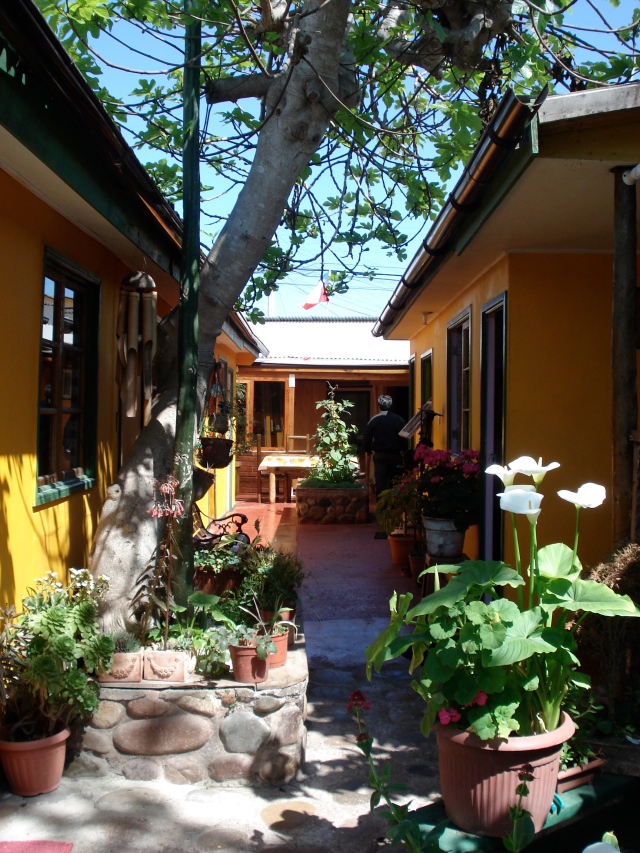
Maria's Casa, our first of many hostels on this journey, but this one had a particularly interesting story... © Chelsea Cook
La Serena is Chile’s pride and joy of beach front property. I have been wanting to see what the fuss was about for a long time, so spending a couple of days here to break up our long journey to the north of Chile seemed like the perfect excuse.
Our hostel, “Maria’s Casa” isn’t mentioned on the popular hostel aggregate web site we often use to secure safe and reliable hostels. We only found out about it because of a small paragraph listed in my travel book. Usually our typical Chilean and Argentinian hostels have been bare-boned, but provided what we needed.

It was a little too cold and windy to wear bathing suits on the beach in La Serena, but the beach was still beautiful. © Chelsea Cook
We were impressed to find Maria’s Casa equipped with an incredible garden (with a lime tree), barbeque, huge and well-supplied kitchen, hot water and Wi-Fi in our bedroom. But the story of how this hostel came to be is much more impressive…
One day, about 15 years ago, Maria was out shopping with a friend of hers from the U.S. They saw an Israeli man who was walking around trying to get help from other people, but he spoke no Spanish. He was looking for a place to stay and all of the hostels in La Serena were already booked. Maria’s friend, who spoke English, talked with the man and Maria, who invited him to stay in the spare bedroom of her house. After two days, he started to become very good friends with one of Maria’s sons, teaching him English and her son teaching the Israeli some Spanish. He ended up staying there for two months. When he left to continue his travel up to San Pedro (as many tourists do), he tried to give her some money, and she refused to accept it.

The famous lighthouse in La Serena, which unfortunately, has become home to a lot of trash and graffiti. © Chelsea Cook
A few days later, a couple knocked on Maria’s door in La Serena.
“Are you Maria?” they asked.
“Yes, I’m Maria.”
“We met a man in San Pedro who told us we might be able to stay with you.”
“Of course,” she said. And the travel tips spread by word-of-mouth. She never charged any of her traveler’s a penny to stay, until one day, three tall Danish men left her $50 without her knowing. With her son’s convincing, she decided to start charging the traveler’s only so that she could expand her house. They gradually put in a couple more rooms, one bathroom, then another, and a washing machine.
She said the real sign that she was an official hostel was when her address showed up in a Chilean travel guide.
Maria still doesn’t charge traveler’s enough for her incredible hostel. But hearing her story, spending time with her and her family, and sharing her kitchen, made us happy to pay for our stay. They kept saying that the way things turned out for them was such a blessing, and the money had enriched their lives. Little do they know, they’ve enriched the lives of so many people like us.
Here’s hoping we can have more positive experiences at the several more hostels we’re about to experience. La Serena was the perfect first stop.
diciendo adios

Orlando, my student for 9 months, and Carolina, his lovely girlfriend, in their Santiago apartment at our last English lesson. © Chelsea Cook
I knew I would enjoy teaching English because I’ve always had a love for language. A love for words, really. But what I loved more than the insight it gave me into my own language, more than the fascinating methods by which language learning is accomplished… what I loved more, was the people I was teaching.
Most of my classes were private, one-to-one students. I would come to their office or home and spend 1-2 hours, 2-3 times per week helping them they best I could. But during this time, especially with my more long term students, I developed relationships- genuine friendships and genuine interest in who we were in our separate lives. Albeit in a sometimes complicated, messy meld of English and Spanish, I had some of the most heartfelt, fascinating conversations with my students. My students were the most grateful and welcoming people I’ve ever worked with.
As goodbye gifts, I’ve received notes, a stuffed dog, a box of marzipan fruit candy, a book and half a dozen eggs from a family farm.
At my last night teaching Maria José, my student Patricio’s 9-year-old daughter, his family invited me to join them for a ceviche dinner, which became dessert, which turned into tea and chocolate and then an all-out Pictionary-like guessing game with English vocabulary words. They all piled in their SUV and drove me to the metro station. MJ began to cry, and after a hug, she asked me to please come back for her birthday in February. I told her I would try, and maybe we could Skype sometime.
It’s so strange to leave this place, where I’ve spent so much time, where I’ve developed a sort of attachment, a home-like feeling. It’s so strange to leave with the confidence that I may very well never return. It’s even harder to say goodbye to these people I’ve formed such a connection with, knowing I may never see them again.
But lucky for me, they all aspire to visit the United States… and lucky for me Atlanta has one of the U.S.’s biggest international airports.
chicos, chicos! escucha!

Bernie, Borja and Camilo, all 4-years-old, in our lesson about body parts. We made sock puppets. © Chelsea Cook
The academic director at SmartEnglish, Santiago’s most upscale and elite English school, contacted me to see if I was interested in some substitute work… for a group of 4 and 6-year-old boys. The pay was really good, so I accepted.
Who knew that Spiderman was such an international symbol?
Although the 4-year-olds were absolutely out of control, I quickly learned the point of the lesson was positive reinforcement. Their parents want their children to enjoy learning English, so that maybe one day they will work hard toward fluency.
The 6-year-olds were much more well-behaved and their level was quite impressive. I would even say that they had a higher level then some of my adult beginners. Alas, they are 6-year-olds. And they are boys. So there was a lot of “pee pee” and “poo poo” talk. But hey, at least it was in English.
dias de patrias

A traditional Rapa Nui dance called the Sau Sau is performed a Parque Intercomunal's Dieciocho celebrations. © Chelsea Cook
- A kite vendor outside of Parque Intercomunal © Chelsea Cook
I’ve been hearing about “el dieciocho” since I arrived to Santiago in January. Now I know why. It’s 7 pm on the 19th of September, the day after “deiciocho”– Santiago’s independence day – and I haven’t left my apartment once. I don’t think anyone has. The entire weekend is reserved for eating too much traditional Chilean food (empanadas, chorizos, shishkabobs, meat, meat and more meat), drinking too much chicha (apple-flavored fermented wine), singing, dancing, and staying up late into the nights in the constantly celebrating plazas, parks and streets of the city. Monday is reserved for rest.
Sometimes living in Santiago feels like living in any big city– the smog, the taxis, the crowded metro, the elevators, the grocery shopping, the laundromat– just all in a different language. So it was an incredible relief (albeit, exhausting) to be reminded that I am indeed in a different culture, living it and experiencing it.
I wish my words could do this weekend justice, but I’m afraid my photos might do a better job. I’ll let them tell the story.

I promise it's not as cruel as it looks: In Chilean rodeo, two cabelleros chase and try to pin a cow against a padded wall. The purpose is to reflect the process of a skilled farmhand. This particular rodeo was for father and son/daughter teams. © Chelsea Cook

Some friends dancing Cueca, a traditional Chilean dance at an asado on San Cristobal. © Chelsea Cook

Two children dressed in traditional Cueca dress play with a patriotic ribbon at Parque Intercomunal. © Chelsea Cook
- Chicha, fermented apple wine, is a typical drink for dieciocho. © Chelsea Cook

Choripan (Chilean chorizo + pan) © Chelsea Cook
el otro lado
When I first began teaching English, one of the things that struck me the most was how professional this job can be. I had imagined that I would work in a school, where students would come to me, and the environment would be relaxed. Little did I know that this business thrives on business professionals. Everyday, I travel to my students’ offices before work, on their lunch break, or right after work. When I walk through the front doors of their buildings, I’m entering their world, and, although it’s in another language, I have to act accordingly. I have to wear business casual clothes and carry an appropriate bag. I have to check in with the front desk and sometimes am given a security badge.
Upon arrival, I’m usually offered a coffee by the company’s maid service or I am welcomed into a conference room with a supply of dry erase markers and sound equipment.
Even when my lessons are privately contracted, they are usually with white-collar workers with beautiful homes. I am greeted by a señora, hired help, who is usually making dinner or vaccuming the living room while my student and I meet. In short, learning English is a status symbol– and for this reason, most of my students are in Chile’s upper economic class.
And then I met Linda. Linda saw my advertisement for private English lessons on olx.cl, the Chilean equivalent to Craigslist. She agreed to my fee and asked if we could meet every Saturday morning in her apartment, while her kids were at their grandmother’s. I wrote down the directions to her apartment and took a bus near my neighborhood. As the bus crossed Santiago’s busiest street, I entered apart of the city I’d never visited: Independencia.
This was what I imagined South America to look like. There are old weather-beaten buildings, bearing the different brightly colored layers of paint that different business owners have worn over the years. There are men making shanty-town like communities in the alley ways and dead ends. There are carnecerías that reek of spoiled meat. Women pushing baby carriages full of found things to try and sell. And a little further down, modest apartment complexes where the other half lives.
I walked into Linda’s complex and was still stopped by a security guard, who gave me no trouble probably because I am Gringa. I winded around the parking lot and saw several groups of children, some kicking a soccer ball, some calling to each other from balcony to balcony. Linda came downstairs to her building with a huge smile and a hug. She was grateful. She apologized for the long hike up her 8 flights of stairs, saying they had no elevator but thought it was good exercise.
Her apartment is mostly a safe haven for her kids. Toys and board games line the walls of the small living room. There are stickers on the windows and electronic equipment. To do listening exercises, we use the computer in her children’s shared bedroom. There isn’t much space, so I sit on the bottom bunk.
Linda knows she’s not like my other students, but she’s attempting something that is extremely rare in Chile: upward mobility. In Chile, the limited access to quality education perpetuates the social classes. The poor can’t afford private education, so they send their kids to public schools. You can’t get into college unless you went to a good school, and you won’t get hired by a good company if you didn’t go to a well-respected college. It’s a cycle that so many of other my students haven’t experienced first hand.
Linda, who already has some fluency in English, is taking this skill and using it to provide better opportunities for her family. Her plan is to soon move to Australia for a few years, where her family can gain fluency in English in a more natural-immersion way. She has the idea to work for a tourism company there. Then, she wants to move back to Chile, to La Serena, one of Santiago’s most popular vacation spots, and open her own branch of the tourism company. La Serena has much better public school options and tourism is booming. It’s good plan, and offers more opportunity than she has now. But it’s fascinating to me that this huge plan revolved around her ability to learn English.
It isn’t until I left the U.S. that I realized what an important, globally-governing country I’m a citizen of. People pay a lot of money to change their lives, just to be little closer to the light that I am privileged to call home.
venta de garaje

MUCHAS COSAS: Walt mans our sale spot in LaStarria. Who wouldn't buy something from that friendly gringo face?
September will mark our very last month as residents of Chile. It’s bittersweet, but the excitement of traveling north to Peru and Ecuador seems to consistently outweigh the things we will miss. And before we say goodbye, we’ll have to pack up. And in order to pack up, we’ve got to get rid of all this stuff!
Through boredom and homesickness, we’ve accumulated many things since January. (Shout out to our mamas for sending so many care packages!) So rather than throw or give away the stuff we can’t fit in our luggage, we’d thought it wouldn’t hurt to try and make a little extra travel money.
Walt and I walked up to LaStarria, a beautiful little area full of foot traffic, carrying everything we could, a blanket, and a couple of good books to read. “What if we don’t sell anything at all?” I remember us thinking. We were oh-so-very wrong.
Saturday’s yard sale, er, sidewalk sale, was a true testament to just how appreciated the U.S. is in Chile. From our used and ripped up English magazines to old clothes bearing American labels, people were thrilled and eager. They asked if we had more clothes, and if we’d be back next weekend.
Soon, our friends joined us and brought a few things of their own.
It was a lucrative idea, to say the least, but the best part about it was the people. It was an incredible way to spend a sunny afternoon- sitting in one of Santiago’s most treasured neighborhoods and having an excuse to talk with people. Most of our “customers” were very interested in why we were here and why we were selling our stuff. Joined by other street vendors, mostly selling crafts, vintage clothing, and homemade baked goods, we were instantly welcomed into a culture that we never knew before.
To date, it was one of our favorite weekends yet. ¡Hasta la proxima!
profesora pequeña
Patricio has been my student since March. He’s head of a team of lawyers at ENAP, Chile’s state petroleum company. Needless to say, he is a very important person with a very stressful job. So our classes have become somewhat of a hobby for him. After signing up for the next level of classes with me, he had the idea of me teaching his daughter also. She’s nine years old. We talked about it for weeks, and he made jokes that although he would pay me for the lessons, it would probably be just as much of a learning experience for me. Little did I know she’d be the best Spanish teacher I’ve ever had.
Before our first lesson, I was incredibly nervous. Sure I’ve babysat for nine-year-old girls before, but teach them another language? Would my Spanish be good enough to even explain our activities? How in the world do I keep her attention for an hour and a half?
So after taking the metro to its furthest point in upper-class suburban Santiago, and then walking 1.5 miles uphill into the base of a ski-resort-like community, I braced myself. Patricio was still at work, and he is the only one in his family who speaks English. I did my best to tell his wife that yes, I found their house with no problem (a lie) and yes, I’d love a coffee. And then I met Maria José. At first she was shy, and handed me her Spanish-English dictionary. She was prepared. And yes, she was only speaking Spanish. Fast.
Something about a boy in her class who was pretending to be a police officer on the playground and he got in trouble with the teacher. Something about her best friend Flavia, who lives two blocks away. Something about a cartoon character named Mrs. Potato? I just smiled and laughed my way through it. We did a few of my prepared exercises where MJ was able to elicit about 50 percent of the body parts in English and then we sang “head, shoulders, knees and toes,” which she loved. But for the most part, she was speaking in only nouns and verbs. This was going to be a challenge indeed.
At the end of class I asked her if she had any questions for me.
“De donde eres?” (“Where are you from?”)
“Soy de Atlanta, en Estados Unidos, conoces?” (I’m from Atlanta in the U.S., have you heard of it?)
“Justin Bieber lives in Atlanta.” She said in perfect English. I couldn’t help but laugh. “I love him,” she said.
So, now I had a topic for my next lesson plan. The great thing about MJ is that she’s patient with me. She can tell when I don’t understand, so she slows down, or uses more simple terms to explain a concept. And then, I teach her that word in English. It is a class of utter chaos between Spanish and English, Spanglish and well, pure curiosity from both parts. Right now well focus on building her noun and verb vocabulary, and maybe a few useful phrases– after all, she’s only nine. I don’t think she’d understand the purpose of the third conditional.
So, as next Thursday rolls around, our third lesson, I’ll be less nervous about my Spanish and more concentrated on reinforcing this positive association that MJ already has with learning English. If she can keep this interest and hobby for the next ten years, she’ll be fluent and have a world of opportunities for college and careers.
And for me, it sure is nice to take a break from business English and bank executives. Sometimes it’s nice to just talk about glitter.
torres del paine ( p a t a g o n i a )
It’s difficult to write about this. Words like “majestic”, “amazing”, or even “overwhelming” seem too cliché to describe Torres del Paine. Saying that there are no words sounds cliché too. Nevertheless, it is really difficult to describe.
Renting a car was a fantastic idea. Because most of the famous hiking trails were closed due to snow, we were able to the park in all its glory in one long, photo-filled day. It’s hard to believe that during the summer months, Torres del Paine National Park is actually crowded. Because we were the only people on the roads and hiking trails, it truly felt like we had the park to ourselves. These mountains and lakes were resting here, untapped and unaware we were watching. At first, the colors of the lakes was most surprising– turquoise and cyan, seafoam green and dusty grays, and then out of nowhere, a deep dark purple. All of these colors paired with towering, intimidating and sometimes haunting mountains– I understand why people endure the harsh camping conditions here.
We had heard that Torres del Paine was crawling with guanaco– a llama-like animal with darker hair and more grace. But when we saw our first two, we mesmerizingly got out of the car to get as close as possible. After snapping a few pictures and taking turns guessing what sounds they make, we continued deeper into the park. We turned the sharp corner of a steep hill and stopped again: the word “colony” doesn’t even begin to explain how many guanaco grazed before us. We soon felt silly for chasing after those first two. For the rest of journey the guanaco were present: walking in a line on the side of the road, drinking from a small stream or grazing on an impossibly steep hill 50 feet above our car. They managed to prance up all the steep terrain with such ease. And they didn’t seem to mind us staring.
Like I said, it’s difficult to describe everything we saw in Patagonia. Many of my Chilean students haven’t been to this part of their own country, so it feels like a really special, unique thing to have been able to experience it. In Spanish, the language uses the verb “conocer” to explain visiting a place. (“Yo conozco Patagonia.”) In English, we either use “to visit” (I have visited Patagonia) or “to see” (I have seen Patagonia) or “to be” (“I have been to Patagonia”). “Conocer” means “to know”. And this verb, for this trip, feels more apt. I visited the landmarks, and saw immeasurable beauty, but most of all, I now know Patagonia. I know why it is so special.



